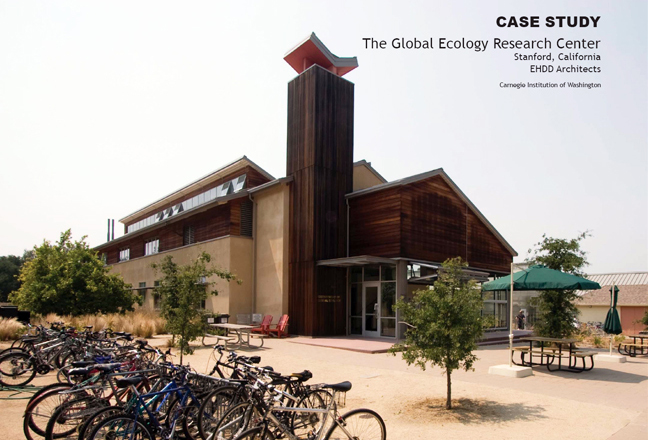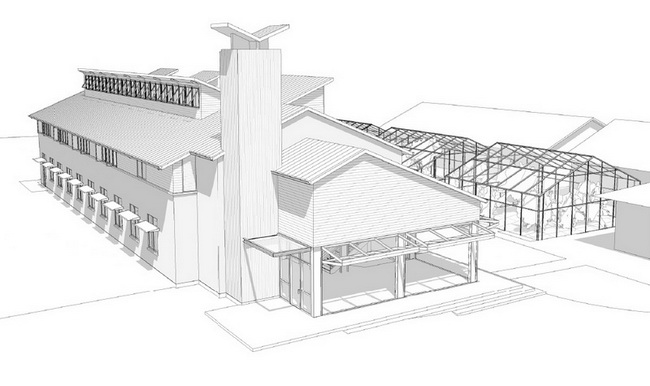|
| |
Carbon Neutral Case Studies |
Global Ecology Center, Stanford, California |
| Project Overview
|

Location: Stanford, California
Building type(s): Higher education, Laboratory, Campus
Construction Type: New construction
Building Area: 10,900 sq. feet (1,010 sq. meters)
Project scope: 2-story building
Setting: Suburban setting
Date of Completion: March 2004
Project Team
DESIGN TEAM
Architect: EHDD Architecture
Structural Engineer: Rutherford & Chekene
Mechanical Engineer: Rumsey Engineers
Electrical Engineer: Lutsko Associates
Civil Engineer: BKF Engineers
Landscape Designer: Lutsko Associates
Lab Design Consultant: Design for Science
Lighting Designer: JS Nolan + Associates
Daylighting Consultant: Loisos + Ubbelohde Associates
Acoustics Consultant: Charles M Slater Associates
Project Mgmt/ Cost Consulting: Oppenheim Lewis, Inc. |
Contractor
DPR Construction
Owner/Client
Carnegie Institution of Washington
Department of Global Ecology
Program
|
Project Statement
The mission of the Department of Global Ecology is to conduct basic research on the interactions between the earth’s ecosystems, land, atmosphere, and oceans. This project unified several buildings and activated spaces on a site that the Carnegie Institution has occupied since 1928, improving contact and circulation between two departments and creating an outdoor collaboration space.
From the Global Ecology researchers’ perspective, the most pressing environmental issues are global climate change, biodiversity, and water issues. The client encouraged the design team to reduce carbon impacts and address biodiversity and water issues while providing laboratory and research spaces that meet the highest standards of comfort and performance. Due to the nature of the research program, flexibility over the short and long term was of utmost importance. Because researchers divide their time equally between field, office, and lab work, all spaces allow for the expansion and contraction of research teams and informal sharing of space.
Project Overview
Global Ecology Research Center at Stanford University is an extremely low-energy laboratory and office building for the Carnegie Institution of Washington. The mission of the new Department of Global Ecology is to conduct basic research on the interactions between the earth’s ecosystems, land, atmosphere, and oceans.
This project unified several buildings and activated spaces on a site that the Carnegie Institution has occupied since 1928, improving contact and circulation between two departments and creating an outdoor collaboration space.
Environmental Aspects
From the Global Ecology researchers’ perspective, the most pressing environmental issues are global climate change, biodiversity, and water issues. The client encouraged the design team to reduce carbon impacts and address biodiversity and water issues while providing laboratory and research spaces that meet the highest
standards of comfort and performance. This focus resulted in a 72% reduction in carbon emissions associated with building operation and a 50% reduction in embodied carbon for building materials.
Proper orientation, exceptional daylighting, sunshading, and natural ventilation set the stage for innovative
mechanical systems. A “night sky” radiant cooling system demonstrates the same principles of radiant heat loss to
deep space in which the researchers are investigating. An evaporative katabatic (downdraft) cooling tower serves as an iconic focal point, while tempering an indoor/outdoor lobby and collaboration space.
The team also aggressively pursued habitat- and waterconservation goals. The exterior wood cladding is salvaged
wine-cask redwood, the interior wood and veneers are FSC-certifi ed domestic ash, tables in the conference room
and lobby were made from trees salvaged from a nearby municipal yard, workstation tabletops were made from
salvaged doors, and recycled aggregate substituted for about 20% of site concrete aggregate. Water use is reduced by one-third through no-irrigation landscaping, dual-flush toilets, a waterless urinal, and low-flow sinks.
Owner and Occupancy
Owned and occupied by Carnegie Institution of Washington, Corporation, nonprofit
Typically occupied by 50 people, 30 hours per person per week; and 15 visitors per week, 2 hours per visitor per
week
Due to the nature of the research program, flexibility over the short and long term was of utmost importance. Because researchers divide their time equally between field, office, and lab work, all spaces allow for the expansion and contraction of research teams and informal sharing of space.
Building Programs
Indoor Spaces:
Laboratory (40%), Offi ce (30%), Lobby/reception (8%), Conference (7%), Restrooms (7%), Data processing (5%), Mechanical systems (3%)
Outdoor Spaces:
Restored landscape (50%), Patio/hardscape (25%), Pedestrian/ non-motorized vehicle path (10%), Parking (10%), Drives/roadway (5%)
Source: High Performance Buildings Data Base
Quick Numbers:
ENERGY UTILIZATION
INTENSITY
(occupied s.f.)
138 kBtu / SF- year
CARBON DIOXIDE EMISSIONS
INTENSITY
(occupied s.f.)
33 Lbs CO2 / SF- year
OCCUPANT IMPORTED ENERGY
INTENSITY
(occupied s.f.)
18.9 MBtu/FTE- year
OCCUPANT IMPORTED WATER
INTENSITY
(occupied s.f.)
461 ccf / FTE - year

Lessons Learned:
Scott Shell, EHDD Architects
1. It’s easy to design a NZEB, the challenge is to make it cost effective and get the actual performance to zero.
2. There is no silver bullet, rather it is about doing a very good job on almost everything.
3. Daylighting is the hardest thing, but the most architecturally rewarding (avoiding heat gain and glare, while getting the lights actually turned off)
4. Reduce energy use by at least half before adding renewable energy sources
5. After reducing everything else by half, plug loads are a large part of the remainder, so what devices and appliances the occupants use is critical
6. Climate change is the issue, so use GHG emissions as a metric converting energy use to GHGs using the local utilities emissions factor (http://www.nrdc.org/air/pollution/benchmarking/db/rank.asp?t=e or Egrid)
7. Most buildings perform significantly worse than intended, so design intent and predicted energy use don’t count, only measured energy use.
8. Measure energy use separately at least for HVAC, lighting, and remainder so you can figure out what is not working as intended after occupancy
9. How occupants use a building has a huge impact on its energy use, yet they rarely understand how it works. Include them and these human factors in the design
10. It is not about superhero green architects, but an integrated team approach. Find the very best engineers, consultants, contractors, and clients to work with, and inspire the team to do their best work together.
11. Architects must have strong technical knowledge about buildings to lead a team, including daylighting, energy use, enevelop design, mechanical and lighting systems, occupant behavior, evolving technologies, etc. This requires continuing lifelong education and research. Some favorite sources: Environmental Building News, http://dotearth.blogs.nytimes.com/ , www.grist.org , http://eetd.lbl.gov/ , http://www.usablebuildings.co.uk/
12. The basic planning and construction of a building are very robust (orientation, glazing percentages and properties, insulation, airtightness, thermal mass, etc). Complex systems and controls often don’t work as intended and drift out of alignment over time.
|

